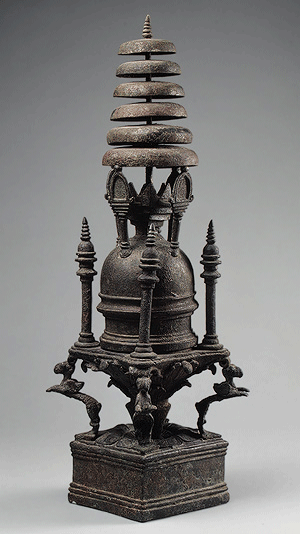The Metropolitan Museum of Art – New York

Model of a stupa (Buddhist shrine), ca. 4th century
Bronze
H. 22 3/4 in. (57.8 cm), W. 7 1/2 in. (19.1 cm)
Gift of Mr. and Mrs. Donald J. Bruckmann,
1985 (1985.387ab)
Stupas, the earliest Buddhist monuments preserved in India, began as solid hemispherical domes that marked the remains of a great leader or teacher.
They were incorporated into early Buddhist art as symbols of the continuing presence of Shakyamuni Buddha after his parinirvana (final transcendence), and as reminders of the path he defined for his followers. Buddhism carried the stupa throughout Asia, where it was interpreted in many forms, including the domed chortens of Tibet and the spired pagodas of China, Korea, and Japan.
The square base and ovoid dome derive from monuments built in northwest India, Pakistan, and Afghanistan during the height of Kushan rule, from the late first to the third century.
In this somewhat fanciful reliquary, the dome of the stupa is separated from its square base by a lotus pedestal and four rampant griffins. It is further elaborated by four columns—capped by miniature stupas—that encircle the dome, and four somewhat enigmatic columnlike forms on top of the base.
The Metropolitan Museum of Art




